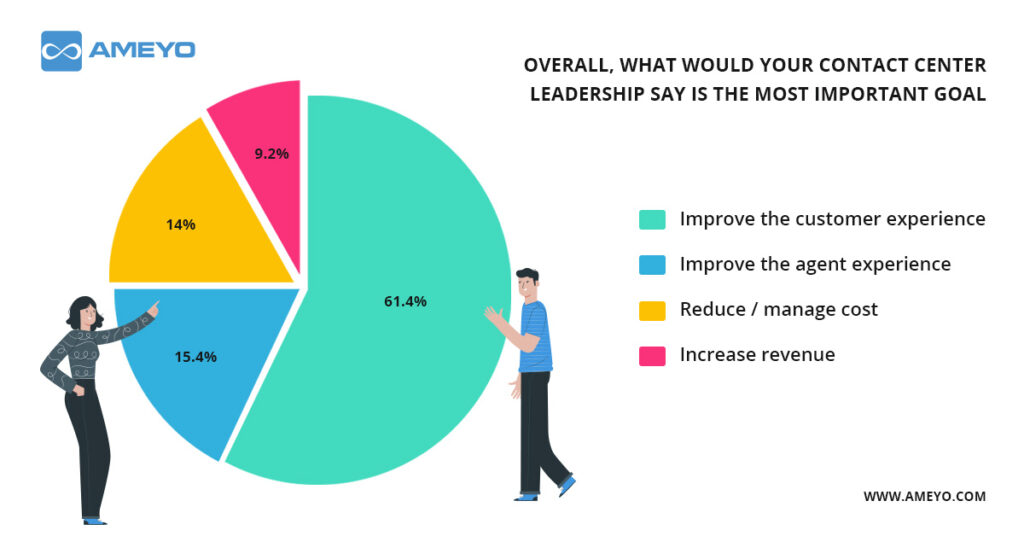What is Workflow?
A workflow is a sequence of recurring tasks, comprising interdependent business processes needing completion to reach a specific goal. It is predictive in nature and consists of various steps executed by numerous systems, people, and departments to reach the common goal.
Workflow is the simplest way to manage recurring processes in your helpdesk ticketing system
The call center or contact center workflow automates the entire process to minimize the processing time and increase all departments’ task execution and performance. Workflows empower the work starting from the start to end and enable a better-coordinated effort to smoothen processes and work simultaneously.
Businesses often try to optimize workflows by automating them where possible and adding features like alerts to draw attention to steps in the workflow that are out of compliance.
What do Workflows mean for a Contact Center?
A contact center helps make customer interactions smoother across various channels, including messaging, email, voice, video, web chat, social media, and more. It enables businesses to connect with customers or vice versa via multiple modes of communication. Using contact center software, organizations can personalize interactions to go beyond the usual inbound and outbound calls and help businesses to serve customers better.
To make the communication process seamless and more effective, one thing is required in the contact centers: WORKFLOW. With workflow integration, contact centers can provide a unified experience, automate the entire process, reduce processing time, and ensure that tasks are completed on time without any delays.
Contact Center workflow management means managing the workflow to ensure that the execution of tasks is efficient, on time, and accurate. It involves numerous employees working from various departments performing their tasks with the required skills at the right time.
The workflow looks at contact centers as a professional workplace where staff members in different departments (such as operations, finance, administration, etc.) are executing their processes to achieve overall customer engagement goals.
At the same time, it understands that the different nature of businesses (such as banking, logistics, edtech, etc.) has different processes. In simpler words, every contact center is a unique business that relies on processes unique to it. Workflow helps you streamline and automate all of those processes.
At a contact center, workflow integration ensures that customer issues are being resolved without delays and proper team functioning is taking place at the right time. Previously, contact centers were used to connect the agents to the customer with Automatic Call Distributor hardware. At the same time, the workflow is operated on software, automates, and makes the entire process much simpler, time and cost-effective.
Workflow at contact centers empowers the agents to segregate their time effectively and focus on essential tasks. It increases employee’s productivity and the customer’s experience.
Need of Contact Center Workflow?
In Contact centers, siloed interactions with no cross-department integrations and clear accountability is resulting in lost revenue and high labor costs. Contact center workflow integration presents an opportunity to reduce these costs and make tasks less labor-intensive.
In addition, automating human tasks with workflow will allow agents to address other important tasks and eliminate the double-entry that agents sometimes need to do to keep multiple systems up-to-date. Workflow automation increases accuracy, alerts managers about the problems, saves time that is spent on monitoring stats.
Reasons why contact centers need workflows:
- Loss of time in repetitive tasks and processes resulting in high operational costs.
- Lack of visibility as the number of customer service requests increases.
- High volume, low priority customer service & support requests often miss the SLAs and get ignored.
- Lack of accountability – owing to multi-department involvement.
- Inefficient reporting & monitoring of processes increase processing time and lost revenue.
Features of Workflow
1) Tasks and Forms
Workflows use predetermined sequences of steps and tasks to route the information among various users. It enables the teams to collect data through forms, analyze the tasks, and view the information to automate existing business processes.
The Tasks reporting allows users to see how many tasks are in the completion process, have been performed, or need to be performed while forms are used to collect information and present it to the users. Forms enable the users to assist quickly and access information that is relevant to your day-to-day operations.
2) Workflow-specific Reports and Dashboards
Helpdesk ticketing Workflow automation highlights the critical information and transforms it into actionable insights through data visualization. The workflow status report shows the complete status of all workflows that are occurring in the system.
A fully customizable workflow dashboard lets users see all assigned workflows in a unified window and maintain compelling workflow reports. The ability to view everything in the dashboard and detailed reports help optimize organizational procedures in a streamlined manner for efficient operation.
3) Workflow Designer
With an intuitive user interface, the workflow designer feature simplifies the steps involved in creating a new workflow and eases the tedious process. It helps the users quickly design, visualize the working process and activate the business workflow to improve working efficiency.
Automated workflows can be planned and designed visually to add, arrange, improve and stimulate the tasks using a drag and drop interface.
Benefits of Contact Center Workflow
1) Improved Efficiency
Automated workflow boosts productivity and improves the efficiency of the agents and managers to accomplish tasks more accurately in less time. It reduces the workload or re-data entry and ensures smooth communication between different business channels. It reduces the overall time by automating repetitive tasks, identifying and addressing the bottlenecks.
2) Reduced Processing Time
Automated workflows at contact centers automate the overall process time and optimize task performance. The agents need to submit the information after completing the call and before picking up another, but this process is time-consuming. Helpdesk ticketing Workflow automation increases productivity by reducing the processing time.
3) Simplifying Delegation of Tasks
Most delegated tasks take some time, planning, and effort to complete properly. Workflow automation enables the superiors to assign the tasks to their subordinates by ensuring effective delegation and making the workload more manageable.
4) Greater Visibility
Helpdesk ticketing workflow automation provides complete transparency to all of the users. They can see all of the features, processes, interdependencies, AHT, the status of requests, time taken for collecting the proofs, and decisions related to manpower under one roof. It also shows the possibilities behind the slowing down of the process and how many change requests have passed through the system.
5) Establish Accountability
The supervisor can assign the tasks to the agents based on the skills and requirements, such as which agent will be accountable for which work and track their performances using SLAs. It enables various stakeholders to measure the agent’s productivity to establish accountability. Automated workflow streamlines the process of routing the invoice from one employee to another for action to be taken based on the business rules.
6) Provide Unified Experience
Automating tasks such as follow-ups or project updates ensures that agents need not remember to send reports to the rest of the team. Workflow automation automatically integrates the departments and enables end-to-end orchestration of work for better collaboration.




